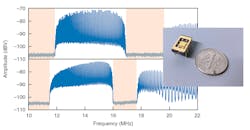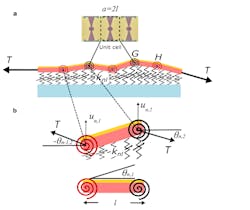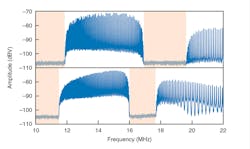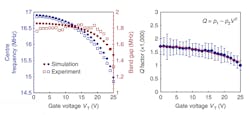Nanoscale MEMS Resonator Structure Yields Controllable MHz-Range Filter, Isolator
As electronic devices shrink, there’s an increasing need for on-chip high-performance functions such as unidirectional waveguides (isolators), filters, and delay lines, especially those with key parameters that can be controlled on chip. A team of researchers from ZTH Zurich and Caltech is using silicon-nitride (SiN) nanomembranes that operate at high frequencies (10-20 MHz) as conduits for phonons, the acoustic-like waves passing through a solid or liquid material to build such devices (a situation very roughly analogous to surface-acoustic-wave, or SAW, devices). The nanoelectromechanical metamaterials (NEMM) include the voltage-controlled frequency tuning of the individual resonators.
They fabricated and tested high-frequency “topological” insulators with six lattice sites in a unit cell. The nanoelectromechanical lattice (NEML) design has periodically etched holes of 500 nm diameter in an extended honeycomb lattice, and insulating Si-rich silicon-nitride (SiNx) membranes (average thickness of ~79 nm) that form a phononic crystal with periodic, curved boundaries (Fig. 1).
1. Scanning electron microscope image of the nonlinear NEML: Simultaneously applying Vdc and Vac voltages to the excitation electrode via a bias tee electrostatically triggers flexural motions while VT is a tuning gate voltage applied to the tuning electrodes to activate on-site electrostatic potentials (scale bar is 10 μm). (Source: Caltech)
The neighboring membranes are overlapped to create mechanical coupling. By changing the distance between etch holes, the researchers were able to control the amount of lattice coupling. Their work has been theoretical, beginning with a discrete mass-spring model and the many forces on each element (Fig. 2). They then proceeded to in-depth, deep-dive physics analysis of the lattice’s electromechanical and related properties, as well as its responses. Finally, they went beyond the theory and its postulated performance by fabricating and evaluating several devices.
2. Shown is the discrete-element model of the NEML for analytical calculation of frequency dispersion. At the top of (a) is the false-color scanning electron microscope image showing three unit cells with the deposited electrodes; at the bottom is a schematic diagram of the mass-spring systems used to solve the dynamic model. A close-up view of a half-unit cell (b) shows the two rotational springs connected by a rigid bar, and the elastic foundation, showing all relevant parameters and degrees of freedom. (Source: Caltech)
By applying a dc gate voltage VT to create a voltage-dependent electric field, they were able to significantly shift the frequency bands of the device (Figs. 3 and 4).
3. Frequency response of the lattices with 120 unit-cells. The upper panel shows the response of the device without electrodes, while the lower panel is with electrodes; the shaded area indicates the frequency stop bands. (Source: Caltech)
4. Position of the bandgap center and size as a function of VT (left). The red and blue squares (dots) show the experimental (numerical) data for the bandgap center and bandgap frequencies, respectively. Averaged Q (quality) factor as a function of VT (right). Q is calculated by averaging f0/Δf of the individual peaks in the frequency spectra for different values of VT; f0 and Δf are the center frequency and full-width at half maximum of a resonance peak, respectively, while error bars represent the standard deviation of the resonance peaks for each VT. (Source: Caltech)
It’s desirable that a physical channel being used as a waveguide be both stable and defect-free for reliable, consistent performance. However, they noted that energy transport in high-frequency mechanical systems, such as these microscale phononic devices, is particularly sensitive to defects and sharp turns because of backscattering and losses.
Since actual devices aren’t perfect, they also investigated the influence of possible fabrication errors that happen during the deposition process. In this case, the non-uniformity in the film thickness causes disorder in the mass matrix parameters used in the many equations of the dynamics.
Another interesting feature of the design is its robustness with respect to waveguide imperfections such as sharp corners. To study this, they also fabricated a zig-zag waveguide with two sharp corners of 60⁰. Their test results showed that the energy transport had negligible backscattering from these corners.
The researchers maintain they have tangibly demonstrated that nanoelectromechanical metamaterials can create on-chip acoustic devices that function as stable yet controllable ultrasound-based, RF signal-processing elements. Their extremely detailed published papers (listed below) provide full analysis of the molecular and lattice physics, the fabrication process for their devices, their simulation results, and actual measured data. Support for the research was provided by the National Science Foundation, the Binnig and Rohrer Nanotechnology Center at IBM Research-Zurich, and the Kavli Nanoscience Institute at Caltech.
References
- Nature Nanotechnology, Jinwoong Cha and Chiara Daraio, “Electrical tuning of elastic wave propagation in nanomechanical lattices at MHz frequencies”
- Nature Nanotechnology, Jinwoong Cha and Chiara Daraio, “Supplementary Information” to main paper
- Nature, Jinwoong Cha, Kun Woo Kim, and Chiara Daraio, “Experimental realization of on-chip topological nanoelectromechanical metamaterials”
About the Author

Bill Schweber
Contributing Editor
Bill Schweber is an electronics engineer who has written three textbooks on electronic communications systems, as well as hundreds of technical articles, opinion columns, and product features. In past roles, he worked as a technical website manager for multiple topic-specific sites for EE Times, as well as both the Executive Editor and Analog Editor at EDN.
At Analog Devices Inc., Bill was in marketing communications (public relations). As a result, he has been on both sides of the technical PR function, presenting company products, stories, and messages to the media and also as the recipient of these.
Prior to the MarCom role at Analog, Bill was associate editor of their respected technical journal and worked in their product marketing and applications engineering groups. Before those roles, he was at Instron Corp., doing hands-on analog- and power-circuit design and systems integration for materials-testing machine controls.
Bill has an MSEE (Univ. of Mass) and BSEE (Columbia Univ.), is a Registered Professional Engineer, and holds an Advanced Class amateur radio license. He has also planned, written, and presented online courses on a variety of engineering topics, including MOSFET basics, ADC selection, and driving LEDs.





